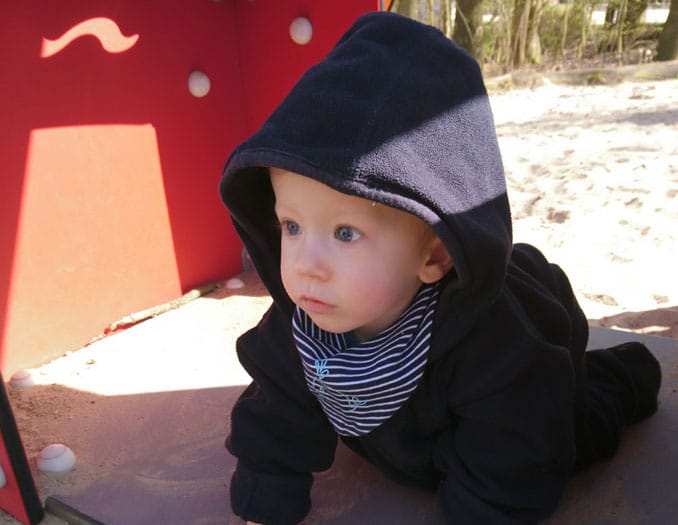Newborns and Infants

A quiet baby is born
Characteristics in infancy
The joy experienced in having the baby was huge. During the pregnancy, the expectant parents had already prepared everything in order to give their future little boy a wonderful welcome into the world. The ultrasound pictures were admired by everyone, the siblings were looking forward to the arrival of their new little brother or sister, mummy relaxed with yoga during pregnancy and daddy told the baby loving bedtime stories while it sat happily in its mother’s tummy. Everything was as it should be, but just occasionally, the mother noticed that her child moved less in her womb. The ultrasound was still normal, only the heart rate was a little too slow. An amniocentesis didn’t show any abnormal findings either. Then – a few weeks before the delivery date – the child turns and positions itself into the breech position and everything suddenly goes by at warp speed. The doctors advise a c-section and the baby is delivered. It’s finally here! But… it doesn’t scream, it seems weak and limp, like a little rubber doll. Mum tries to breastfeed her baby, but it hardly suckles or swallows. Feeding is a very laborious task and the baby often falls asleep. But the baby sleeps a lot anyway. It hardly reacts to external stimuli. Soon enough the doctors have to fit the baby with a feeding tube so that it gets enough nutrients. The parents feel insecure. Something is wrong with their beloved baby…
This is what the stories of newborns with Prader-Willi syndrome and their parents can look like. In retrospect, there were some abnormalities that indicated PWS. In prenatal diagnostics, however, this syndrome is hardly detectable due to its rarity.
- reduced foetal movement during pregnancy
- pronounced muscle weakness, baby is lethargic, weak, limp, like a rubber doll (“floppy infant”)
- very quiet, sleeps a lot, often has to be woken up for feeding
- suckling weakness, often given nutrition through a feeding tube
- mostly underweight, difficulty gaining weight
- testicular hypertension and small penis in boys, underdeveloped labia in girls
A quiet baby is born
The joy experienced in having the baby was huge. During the pregnancy, the expectant parents had already prepared everything in order to give their future little boy a wonderful welcome into the world. The ultrasound pictures were admired by everyone, the siblings were looking forward to the arrival of their new little brother or sister, mummy relaxed with yoga during pregnancy and daddy told the baby loving bedtime stories while it sat happily in its mother’s tummy. Everything was as it should be, but just occasionally, the mother noticed that her child moved less in her womb. The ultrasound was still normal, only the heart rate was a little too slow. An amniocentesis didn’t show any abnormal findings either. Then – a few weeks before the delivery date – the child turns and positions itself into the breech position and everything suddenly goes by at warp speed. The doctors advise a c-section and the baby is delivered. It’s finally here! But… it doesn’t scream, it seems weak and limp, like a little rubber doll. Mum tries to breastfeed her baby, but it hardly suckles or swallows. Feeding is a very laborious task and the baby often falls asleep. But the baby sleeps a lot anyway. It hardly reacts to external stimuli. Soon enough the doctors have to fit the baby with a feeding tube so that it gets enough nutrients. The parents feel insecure. Something is wrong with their beloved baby…
This is what the stories of newborns with Prader-Willi syndrome and their parents can look like. In retrospect, there were some abnormalities that indicated PWS. In prenatal diagnostics, however, this syndrome is hardly detectable due to its rarity.
Characteristics in infancy
- reduced foetal movement during pregnancy
- pronounced muscle weakness, baby is lethargic, weak, limp, like a rubber doll (“floppy infant”)
- very quiet, sleeps a lot, often has to be woken up for feeding
- suckling weakness, often given nutrition through a feeding tube
- mostly underweight, difficulty gaining weight
- testicular hypertension and small penis in boys, underdeveloped labia in girls
Suspected diagnosis – a genetic test provides clarity
Luckily the parents in the neonatal ward in the hospital meet with doctors who have a suspicion regarding the symptoms presented by their baby. If the newborn is still lethargic after a few days, the child is examined for certain gene defects after the parents have been informed. Blood samples are submitted to genetic laboratories for this purpose. If there is a suspicion of a defect on chromosome 15, the baby’s blood is analysed in a so-called methylation test, the results of which are usually available after a few weeks. A difficult time begins for the parents. They were so looking forward to having a healthy child! A deep abyss of grief, despair and fear suddenly opens up.
“Our child may have a genetic defect? Prader-Willi Syndrome? Never heard of it!” Information is hectically collected, the Internet consulted, devastating facts are read, videos watched on the Net, and most of these things are discouraging. “A handicapped weak-muscled child with a food addiction? How’s that going to work? We love cooking and eating in our family.” Emotions run wild. The parents look at their quiet, weak newborn with great concern. If it weren’t for those little curious eyes ...
Suspected diagnosis – a genetic test provides clarity

Luckily the parents in the neonatal ward in the hospital meet with doctors who have a suspicion regarding the symptoms presented by their baby. If the newborn is still lethargic after a few days, the child is examined for certain gene defects after the parents have been informed. Blood samples are submitted to genetic laboratories for this purpose. If there is a suspicion of a defect on chromosome 15, the baby’s blood is analysed in a so-called methylation test, the results of which are usually available after a few weeks. A difficult time begins for the parents. They were so looking forward to having a healthy child! A deep abyss of grief, despair and fear suddenly opens up.
“Our child may have a genetic defect? Prader-Willi Syndrome? Never heard of it!” Information is hectically collected, the Internet consulted, devastating facts are read, videos watched on the Net, and most of these things are discouraging. “A handicapped weak-muscled child with a food addiction? How’s that going to work? We love cooking and eating in our family.” Emotions run wild. The parents look at their quiet, weak newborn with great concern. If it weren’t for those little curious eyes ...
Feeding takes time
Finally back home, feeding the newborn takes a lot of time. Some mothers try to breastfeed the baby, which is rarely successful due to the weak sucking and swallowing reflex and may take 1-2 hours at a time. Sometimes feeding with a bottle and a large teat or finger feeding helps. If the baby is fed via a feeding tube, it can also receive pumped breast milk. Often lots of small meals are required to ensure that the baby receives the right amount of fluids needed for an infant to thrive. Since some babies with PWS have breathing problems due to their muscle weakness, a monitor watches over them while they sleep.
An outpatient nursing service also helps with the regular changing of the feeding tube.
If the genetic laboratory confirms during this time that their baby really has Prader-Willi Syndrome, it is important for the parents to look for trustworthy medical caregivers, such as a paediatrician who may already have experience with children with PWS or who is at least willing to deal with the disability. The socio-paediatric outpatient clinics at children’s hospitals are also important contact points for parents and children, as are the Prader-Willi outpatient clinics, which are located throughout Germany. There, the parents are advised by experienced geneticists and endocrinologists.
A personal exchange with other parents of children with PWS can also be helpful. They are often already one or two steps ahead in the development of their child and can provide many helpful tips. Above all, it is important for them to communicate that living with a child with PWS can be just as enriching and beautiful as living with a healthy child. The national group leaders at the PWS Association will be happy to put you in contact with other families. Many parents also use the forum on this website to exchange ideas. In addition, the PWS Association regularly offers workshops and family weekends for all age groups.
Slowly the baby becomes more active
During the first year of life, babies with PWS slowly become more lively and awake despite their muscle weakness. They drink better, gain weight and begin to react to their environment. Babies with PWS are often very sweet. They seem very happy. And paradoxically, parents feel happy when their little ones cry less for the first time. Sensomotorically, however, these children develop more slowly than healthy children. Parents should be vigilant if they believe that their baby is unwell.
People with PWS have a lower pain sensation, so there is no normal pain response. They also have problems with body temperature control. This is why even severe infections in infants and young children often occur without a fever or elevated temperature. Most people with PWS cannot vomit. For this reason, the emergency doctor should be called immediately if vomiting occurs.
Slowly the baby becomes more active

During the first year of life, babies with PWS slowly become more lively and awake despite their muscle weakness. They drink better, gain weight and begin to react to their environment. Babies with PWS are often very sweet. They seem very happy. And paradoxically, parents feel happy when their little ones cry less for the first time. Sensomotorically, however, these children develop more slowly than healthy children. Parents should be vigilant if they believe that their baby is unwell. People with PWS have a lower pain sensation, so there is no normal pain response. They also have problems with body temperature control. This is why even severe infections in infants and young children often occur without a fever or elevated temperature. Most people with PWS cannot vomit. For this reason, the emergency doctor should be called immediately if vomiting occurs.


